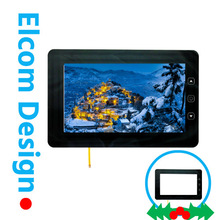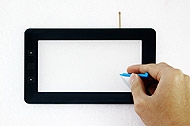How resistive touchscreen panel work
The structure of a touch screen basically consist of two layers . The top layer is typically PET film, hard coated on the non-conductive side to prevent scratches. And the bottom layer that can be made from PET film or Glass. Then the conductive sides of the top and bottom layers are coated with ITO (Indium Tin Oxide) for superior electrical conductivity and optical transparency. These layers are separated by printed, transparent, non-conductive dots to provide the spacing. When touched, the two conductive layers come into contact and then the controller will determine the coordination by calculating the voltage at the touch point.
4-wire touch panel and 5-wire touch panel
Resistive touch panels are generally divided into 2 types: the 4-wire touch panel & 5-wire touch panels, which are known as analog resistive touch screen. And the Matrix is what is known as digital resistive touch panel. Elcom, as an professional resistive resistive touch screen manufacturer, we manufacturing variety size of each type of the resistive touch panels that satisty all kinds of interactive equipments. Except for standard models, the customize models are available, please contact us if needed. Elcom has more than 500 employees in mainland China and Taiwan work together to provide exceptional quality services with professional experience and skills to our customers around the world.
FILM to GLASS resistive touch screen
The film-to-glass resistive touch panel technology is the preferred solution for applications that require input flexibility, ease-of-integration, low power consumption, and superior resistive optics. Elcom Design offers 4-wire touch panel and 5-wire touch panel for this product as well. These resistive touch screens will accept input from a stylus, fingers, and gloved hands. The variety of film-to-glass touch screens we offer provide reliable, durable performance in a wide variety of environments and our optional anti-glare and anti-reflective coatings provide superior readability in sunlight for outdoor applications.
FILM to FILM resistive touch screen
Our film-to-film resistive touch panel technology, with polycarbonate or glass backing plate, is the preferred solution for ease of integration into your rugged touch product.
With tried and tested design, Elcom offered 4-wire and 5-wire film-to-film resistive touch panels, gives our resistive touch panel exceptional durability, because we use specially formulated optical-grade adhesive to bond the switch layers to the polycarbonate or strengthened glass backing plate, creating a shatter-resistant touch panel that has the ability to withstand temperature and humidity extremes found in harsh indoor and outdoor environments.
Resistive Touch Screen Tail Types :
5 Wire Touch Panel
5 Wire Resistive Touch Panel

Customized 5 Wire Touch Panel

4 Wire Touch Panel
Customized 4 Wire Touch Panel

4 Wire Resistive Touch Panel

Other resistive touch panel types
Water-Proof Resistive Touch Panel

Matrix

Traditional touch screens are laminated to the display panel and is installed underneath the bezel cover of a device, which produce a depressed appearance of the display panel. To achieve a fully flat touch interface, touch lens technology integrates the display lens with the face cover to create a seamless look and feel.

Touch lens is essentially a redesign of the traditional resistive touch screen technology. a perfect combination of the 4 wire design and lens integration (PET film with printing).
As more and more devices are designed to feature increasingly flat touch modules, a diverse range of applications are also emerging to compliment this technology, thus making touch lens design a popular choice
Specification of Touch Screen
| Electrical |
Maximum Circuit Rating |
5V DC, 35mA |
|---|
| Insulation Resistance |
Maxtrix 20MΩ or more at 50V DC |
| |
Analog 20MΩ or more at 25V DC |
| Dielectric Withstand |
250V Rms (50-60Hz 1min) |
| Contact Bounce |
30ms or less |
| Mechanical |
Actuation Force |
10g to 100g |
|---|
| Linearity |
1.5% or less |
| Life Expectancy |
35,000,000 touches |
| Surface Hardness |
3H or more |
| Glass Thickness |
0.7mm, 1.1mm, 2.0mm, 3.0mm |
| Environmental |
Operation Temperature |
-10°C to + 60 °C |
|---|
| Storage Temperature |
-20°C to + 70 °C |
| Humidity |
40°C , 90% to 95% for 240 hours |
| Optical |
Transparency |
≥80% ± 2% |
|---|
| Structure |
Film to Glass |



